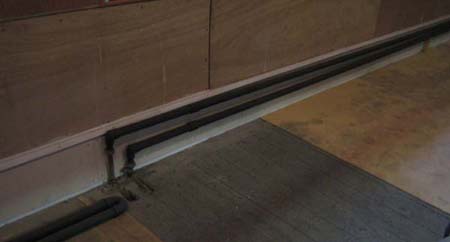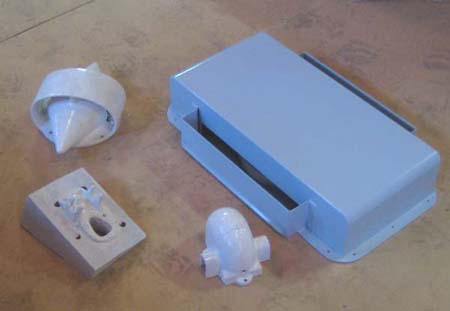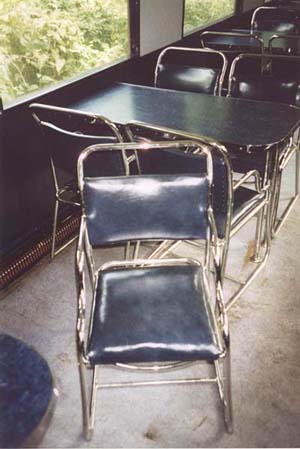
The steam heating pipes were unearthed from their lair for the past 10 years
and Robin and Chris stripped the rust off before Dave Simpson painted them with heat resistant paint. Suddenly someone
realised that the interior plywood wall cladding would have to be cut just above the heating pipe level so that the heating
pipes could be fitted independently of the Rexine-type wall covering. All 22 of the clips needed to hold the heating pipes i
n place were also descaled and painted with heat resistant paint. The lower part of the plywood cladding was the permanently
screwed into place and the top part temporarily refitted. The square moulding to which the heater cover top is fitted was
manufactured, drilled and painted prior to fitting.
As can be seen from the photo, some adjustment is required to the
steam supply pipes at floor level as the heating pipes are sitting too high above the floor. This is probably due to BR
modifications in the 50's. Our thanks to Alex King for his help with these modifications.
Alan Wilson has spent
many hours trying to get some life back into the Bowden cables used to operate the steam valves beneath the floor. There
are only two valves in place, both of which have been persuaded to operate, but the third one to control the pipes opposite
the bar is missing and is proving difficult to source.


The sealing of the roof highlighted all the components which had to be fitted on the roof. All of these existed except for one
of the supports for the Passcom butterfly valve on the north side, so this had to be re-manufactured from bits of glued together
teak framing. It is amazing just how large a piece of teak was required to cut this odd shaped support from. After application of
gold size, all the steps and brackets for the roof were painted white prior to fitting.
The torpedo ventilators for the roof have been cleaned up and painted ready for fitting. New roof cowlings for the exhauster
fan in the kitchen and the boiler flue have been manufactured, painted and prepared for fitting on the roof.
Eric Viles, that venerable gentleman who was still collecting tickets when aged 90 years old very kindly left some
money to the Society on top of which was put an appeal in the Autumn 2006 Blastpipe for funds to provide the chairs, table
edging and table supports for the coach. These reproductions were to be made from polished stainless steel on advice from the
North Norfolk Railway.
The rail for the top of the bar also required manufacture from new as did the foot rail along
the bottom of the bar. The interior of the saloon was also measured up for Rexine-type cladding for the walls, linoleum for
the floor and bar top, and heavy industrial lining paper for the ceiling.
The illustration is of one of the chairs in
641 on the North Yorks Moors Railway. One of the tables can also be seen in the background.


Hardwood edging has been made for the bar top and an infill base made from plywood. This will be topped off with linoleum to match the floor colour. Another development in the bar area has been the fitting of a washhand basin set into the top shelf nearest the boiler. Advice from a boiler inspector dictated that steel plating was required all round the boiler, and in addition to that, insulating board would have to be fitted against all the wooden parts close to the boiler. To facilitate servicing the boiler, an access hatch was cut in the bar front. Not a simple job as framing was required to support both the remaining bar front around the hatch hole and the removable hatch itself.